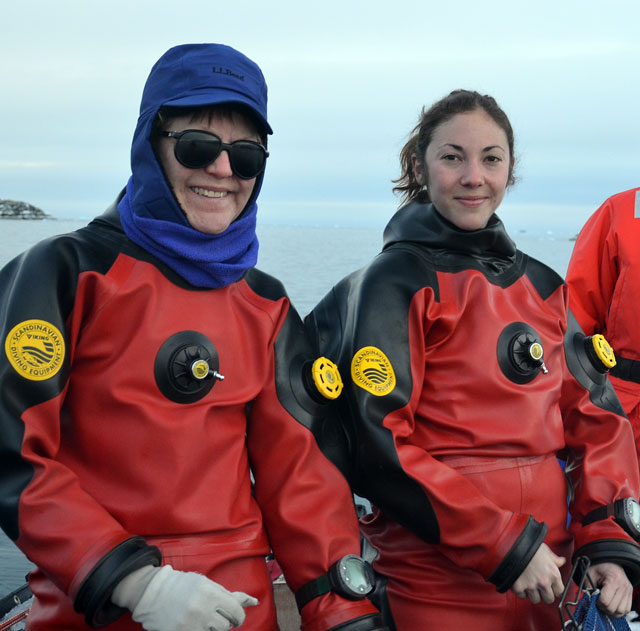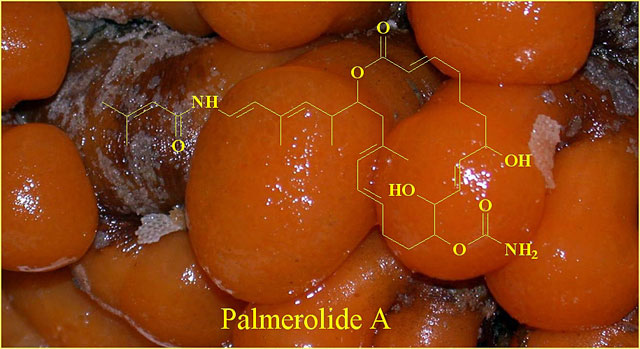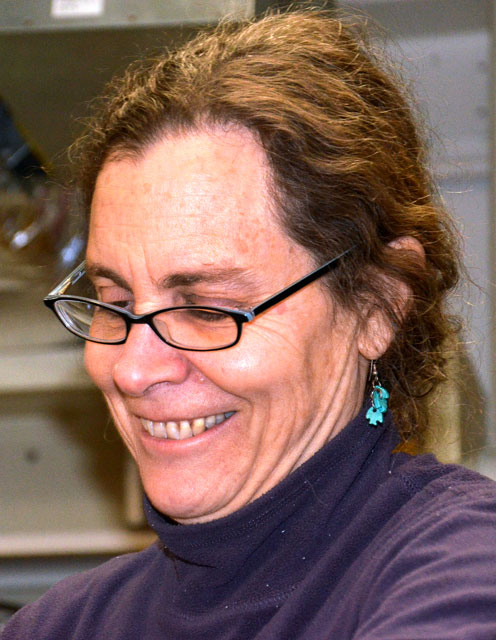|
Page 2/3 - Posted July 1, 2011
Antarctic research may lead to cancer-fighting drugThe surface bubbles now passed in tandem to the other side of the boat, farther from shore, and then slowly back. Chuck and Ruth remained underwater for nearly 30 minutes before resurfacing, each with a sack full of algae. Kate and I helped Chuck and Ruth back into the Zodiac, along with their weighty tanks and the precious foliage. We then headed straight back to Palmer Station, where grad student Julie Schram In the lab, Chuck and his co-workers prepare extracts of the algae and identify which ones drive amphipods away from foods they otherwise scarf down. Those samples go to Tampa to Chuck’s co-principal investigator, Bill Baker Baker, who was at Palmer earlier this season before my arrival, is professor of chemistry at the University of South Florida Through such studies of the algae and invertebrates in the waters around Palmer Station, Amsler, Baker and James McClintock One of them, a polyketide macrolide isolated from the tunicate Synoicum adareanum named Palmerolide A (in honor of Palmer Station), has been found by colleagues at the National Institutes of Health Ten days after my vertiginous voyage, I had another chance at the helm. We headed west, around Torgersen Island to Norsel Point, at the western tip of Amsler Island, named for Chuck and Maggie, who have done extensive ecological research here over the last 30 years. Chuck had me cruise up the south shore of the island to recon for leopard seals. No leps, but we spotted a fur seal rolling through the water contentedly. Maggie and Ruth dove there for about 25 minutes to retrieve some of the benthic (bottom-dwelling) sponge Dendrilla membranosa, which Chuck placed in liquid nitrogen immediately after Maggie and Ruth were back in the Zodiac for later chemical analysis. I drove the Zodiac back toward the station as a cormorant soared overhead. Along the way, we encountered another labyrinth of brash ice and blue icebergs that had calved from the glacier over the preceding week. I meandered through it, at home now on the water, at the tiller and among the ice. On our final approach, looming up before us was the Gould, which minutes earlier had just returned to Palmer’s pier after a three-day fishing trip. Kristin O’Brien and Elizabeth (Lisa) Crockett When Antarctica and Australia split up 38 million years ago and went their separate ways, the waters around Antarctica cooled to the freezing point as the new continent drifted south. Its gargantuan ice sheet began to take shape and the Antarctic Circumpolar Current formed. Into this extreme, foreboding environment swam the notothenioids, which now comprise half of all fish species that live on Antarctica’s continental shelf. Their success stems from many elegant adaptations to the cold, foremost among them being their antifreeze glycoproteins that evolved from pancreatic enzymes to bind nascent ice crystals and keep their blood and other tissues fluid in frigid waters. These amazing creatures have gotten so good at thriving in the cold that their very existence may now hinge on it. Climate change could turn these icefish into the proverbial canary in the coalmine, so Kristen, Lisa and their colleagues want to learn as much as they can about how notothenioids may respond to a warming ocean. It’s easy to understand why Lisa chose this for her life’s work. From 1928 until 1930, a young Harvard student, who many years later became her father, served with geologist Laurence M. Gould as a key member of the Antarctica team in the South Pole expedition of Adm. Richard E. Byrd. Behind Bio Lab stands a series of cylindrical aquaria that resemble backyard swimming pools, each pumped with fresh seawater from Arthur Harbor a few yards away. In the first of these were the newly arrived Notothenia coriiceps, a common species in this group, their camouflage-khaki skin making them hard to pick out amidst the brown algae of their habitat. Swimming nonchalantly one tank over were their flamboyant cousins in the Nototheniidae family, Gobionotothen gibberifrons, or gibbies, with their spotted blonde coats and extra-big, protruding eyes. In the third and largest tank were two species of their slightly more distant relatives from the Channichthyidae family that I heard so much about and was excited to meet — the icefish. In a molecular mishap between 5.5 and 2 million years ago, the icefish lost the ability to manufacture hemoglobin, and some species have since also lost their ability to produce myoglobin, giving them blood as clear as mineral oil and muscles as white as candle wax. Yet they prosper in the frigid, oxygen-rich waters of the Southern Ocean. On approaching their tank I was instantly captivated. They swim with the grace of ballerinas, twirling, rather than flapping, their fanlike pectoral fins. Seconds after I began watching them, a group gathered at my edge of the tank, bobbing halfway out of the water at me, like puppy dogs at a pet shop. I locked eyes with several, who gaped their huge jaws into a magnetic greeting, a friendly fish smile, as if to say, “Look, I couldn’t bite you even if I wanted to. I have no teeth!” (They do, but they’re very fine, harmless cartilaginous bristles.)Back 1 2 3 Next |



For USAP Participants |
For The Public |
For Researchers and EducatorsContact UsU.S. National Science FoundationOffice of Polar Programs Geosciences Directorate 2415 Eisenhower Avenue, Suite W7100 Alexandria, VA 22314 Sign up for the NSF Office of Polar Programs newsletter and events. Feedback Form |








